|
Our manuscript on "Measuring and Modeling Stable Isotopes of Mobile and Bulk Soil Water" was selected for the Outstanding Paper Award, 2020 by the Vadose Zone Journal Editorial Board. The "article was selected based on how it has advanced knowledge in the profession, the effectiveness of communication, methodology, originality, and impact". All ASA, CSSA, and SSSA awardees were announced in the latest CSA news that can be found here. I am personally very happy to see that our work has made some impact and was well received by the community. The presented study is a great example for a successful collaboration where data and model code have been shared openly to gain new understanding in subsurface hydrological processes. The work was done within the EU-funded VeWa project and you can find more publications and info here.
0 Comments
Plant water stable isotopes had not been used widely to study plant water use across Northern environments. Doerthe Tetzlaff's EU funded VeWa project addressed this research gap and an inter-site comparison of five involved sites has now been published in Hydrological Processes (open access). We show how the sampled xylem isotopes compare to precipitation, groundwater, and soil water and discuss why there is often a mismatch between the plant water and their potential sources.
Since I met Scott in November 2017, we discussed about the concept of "ecohydrologic separation", as introduced by Renée Brooks and colleagues in a Nature Geoscience paper in 2010. In early 2019, we decided to write our thoughts down in a commentary, which was now published in the journal Water Resources Research, titled: "What ecohydrologic separation is and where we can go with it". Our main messages are:
A) Isotope ratios of plant water should differ from water flowing in soils to streams & so we need to move beyond confirming this difference B) By focusing on dynamics of how water infiltrates into the subsurface & becomes available to plants we can better interpret past findings C) We discuss four aspects that should be considered:
A paper from the current collaboration with the Surface Hydrology and Erosion Research Group at IDAEA-CSIC, Barcelona, was recently published in a special issue on "Using water age to explore hydrological processes in contrasting environments" in Hydrological Processes. Under the lead of Francesc Gallart, we present a study on "Investigating young water fractions in a small Mediterranean mountain catchment: both precipitation forcing and sampling frequency matter" that highlights how sampling frequency and the rainfall dynamics impact estimations of the young (2-3 month) water fraction in the runoff. We found that this measure of young water fraction depends highly on the runoff dynamics with almost all runoff being young during the highest discharge events. Our findings, based on data from the Vallcebre Catchment in the Pyrenees, are for example relevant for inter-catchment comparisons based on estimated young water fractions, since the sampling design and the runoff responses should probably be considered in such approaches. A pre-print can be downloaded from researchgate and a final version can be requested via email if you do not have access to manuscripts published in Hydrological Processes.
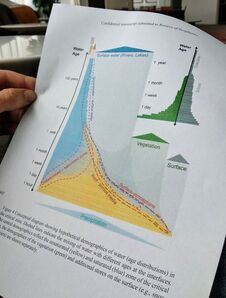 Looking at the demographics of water in the critical zone. Looking at the demographics of water in the critical zone. The literature in hydrological science on how long a rain drop takes to pass through the soil, may be taken up by trees, end up back in the atmosphere via evaporation, or recharge the groundwater and streams is ever growing (see graph below). In our accepted manuscript on "The demographics of water: A review of water ages in the critical zone", we provide an overview on the current developments and open questions in this vibrant field dealing with water ages to improve the understanding of flow paths. This manuscript evolved from a workshop on “Water Ages in the Hydrological Cycle” held in October 2017 in the Black Forest funded by the Wassernetzwerk Baden-Württemberg. Back then, we discussed for about three days our experiences, new thoughts and challenges in estimating water ages in the terrestrial water cycle. 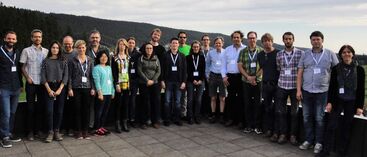 Participants of the workshop on "Water Ages in the Hydrological Cycle". Discussions at this workshop initiated the review paper. Participants of the workshop on "Water Ages in the Hydrological Cycle". Discussions at this workshop initiated the review paper. Our interdisciplinary group of scientists brought together various aspects that appear to be relevant for a better understanding and would be worth looking into in the future. This review manuscript is the result of these discussions at the workshop and via emails afterwards. It has been a great experience to work with that many bright scientists and put different views based on different backgrounds together. The collaborative and supportive atmosphere within the group of co-authors were extremely motivating and a great example for the success of interdisciplinary work. Thanks to the Wassernetzwerk Baden-Württemberg and the DFG for the financial support to work on this manuscript. You can download the accepted manuscript here. 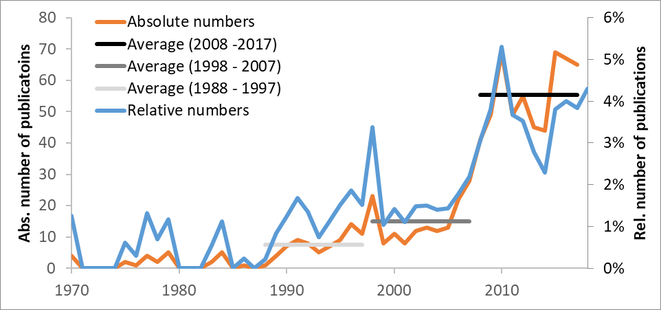 Annual numbers of publications (orange line) with either "Travel times" or "Transit times" or "Water age" or "Residence times") in their title or keywords published in the journals “Water Resources Research”, “Journal of Hydrology” or “Hydrological Processes”. Horizontal lines indicate the average values over the indicated decade. Numbers of publication are also given in relation to the total number of publications in the considered journals (blue line, given in %). (Figure is not part of the review manuscript.) We present in HESSD an extensive stable isotope data set gathered by the Surface Hydrology and Erosion group at IDAEA-CSIC, Barcelona. Our study sheds light on the hypothesis of “ecohydrological separation” that was stated in the seminal paper by Brooks et al. (2010) almost ten years ago. Their publication initiated many stable isotope (2H and 18O) studies in ecohydrology, tree physiology, and vadose zone hydrology. However, the mechanism of how two subsurface water pools of different isotopic compositions evolve and persist are not yet understood.
This lack of understanding is partly due to insufficient sampling frequencies of isotope data in the field. We overcome this limitation by a unique sampling design gathering isotope data of mobile and bulk soil water, rainfall, groundwater, and stream water in a fortnightly frequency over 8 months. We further extended our study by four years using long-term stable isotope and soil moisture data to reveal that the seasonal dry down of the soil and the wetting up of the soil pores with isotopically distinct rainfall can explain the disjunct isotopic compositions of water that is either stored in the soil or routed quickly to the groundwater and streams. Our findings provide the scientific basis to refute the often-made assumption in environmental modelling that water is well mixed in the subsurface. We further provide suggestions on how to implement our findings in future modelling frame works, by accounting for pore scale variability of water transport. During my visit at the Center for Agricultural Resources Research in Shijiazhuang, Hebei last summer, I got involved in the work by master student, Meijia Zhu, who gathered an impressive hydrochemical data set in the Xiong’an New Area. I learned that this area will provide new housing for the ever growing region around the Chinese capital. However, the North China Plain, where these developments take place is characterized by a dramatic drop in the groundwater levels over the last decades due to its over consumption; mainly for agricultural use. Due to the water scarcity related to the groundwater mining, rivers, are running dry. To counter this development water gets regularly transferred from other basins (see Figure 4). Though, often, the river flow is dominated by sewage water from urban areas. The work lead by Meijia Zhu now shows that this sewage water is not only affecting the water quality of Lake Baiyangdian, largest freshwater lake, but it also aggravates the underlaying groundwater body. We see, that the Chloride and electrical conductivity increases along the groundwater underlying studied river that flows into the Lake Baiyangdian (see Figure 6). We used end-member mixing analysis to show the ratio groundwater recharge sourced from either rainfall, lake water, or river water (see Figure 9). The study shows clearly how the groundwater body is not only threatened by depletion, but that the combination of over use and sewage disposal into rivers affects the groundwater challenging the water supply of the new developing Xiong’an New Area. 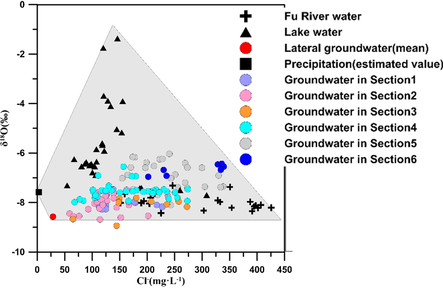 Figure 9. d18O values versus Cl- concentrations of the groundwater and end-members. The mean values of Cl□ concentration and stable isotopes of the Fu River water in seasons without the influence of the precipitation and transferred water (samples collected in January 2018 and March 2018) were taken as values of one end-member that reflects sewage influence. The manuscript to this study is openly available here.
Zhu M, Wang S, Kong X, Zheng W, Feng W, Zhang X, Yuan R, Song X, Sprenger M (2019): Interaction of Surface Water and Groundwater Influenced by Groundwater Over-Extraction, Waste Water Discharge and Water Transfer in Xiong'an New Area, China, Water, 11(3), 539, doi: 10.3390/w11030539. You are invited to submit your study to a special issue on "Hillslope Hydrology: Towards Improved Process Understanding Using Modeling and/or Field Observations" in the open access journal Water. If you are working currently on a hillslope study and plan to submit the results of your investigations in 2019, please consider this special issue that I organize together with Jaromir Dusek, Ali Ameli, and Shiqin Wang. Deadline for submission will be December 2019 and please do not hesitate to contact us if you have questions. Info can be found on the homepage and in the flyer (PDF download).
Our study on water ages in the soil, transpiration, evaporation and recharge got published in Hydrology and Earth System Sciences after a lively discussion during the open peer-review process. We simulated how long the water travels through the compartments of the critical zone and also the median age of the water in each compartment. We found that the travel time distribution is not necessarily the same for evaporation and transpiration, as the roots access older water in deeper soil layers than the evaporation. Further, the travel time of the recharge flux is mainly driven by flushing events, when there is high recharge during winter (in Scotland) or during snow melt (in Canada and Sweden). Water ages are generally lower the higher the storage and increase with decrease in soil wetness. This is true for recharge and also evaporation and transpiration fluxes. We hope to contribute with this to the ongoing research on how the soil-plant interactions affect the water flow and transport in the upper critical zone. You can download the manuscript here.
We compiled stable isotope data (2H and 18O) of bulk soil water at five long-term experimental catchments across a hydro-meteorological gradient in the northern latitudes (Figure 1). The comparison of the extensive data set, covering different landscape units at each catchment, showed that vegetation, topography and elevation affect the isotopic composition over time and soil depth. Soil water beneath conifers is more enriched in heavy isotopes than beneath heather or oak vegetation. Sampling sites closer to the stream are generally less variable in their stable isotopic composition than sites at gentle hillslopes. Isotopic fractionation due to soil evaporation was observed mainly in the top 10 to 30 cm and was mainly controlled by the precipitation amount while temperature (as proxy for evaporation) was less important and soil moisture did not influence the isotopic fractionation, as revealed by multiple linear regression. The study will be published (here) in a Special Issue on "Water in the Critical Zone" in Hydrological Processes. The work was funded by the ERC grant VeWa and you can find a presentation by Doerthe Tetzlaff about that project here. |
Archiv
May 2022
Kategorien
All
|


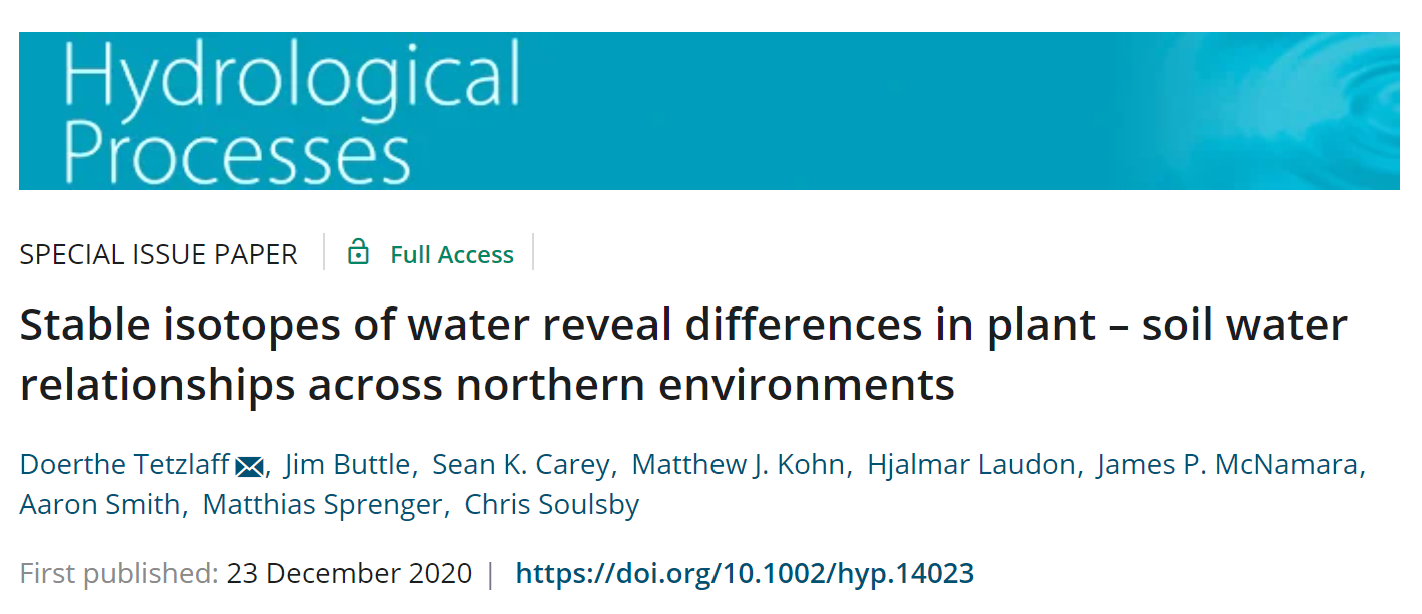
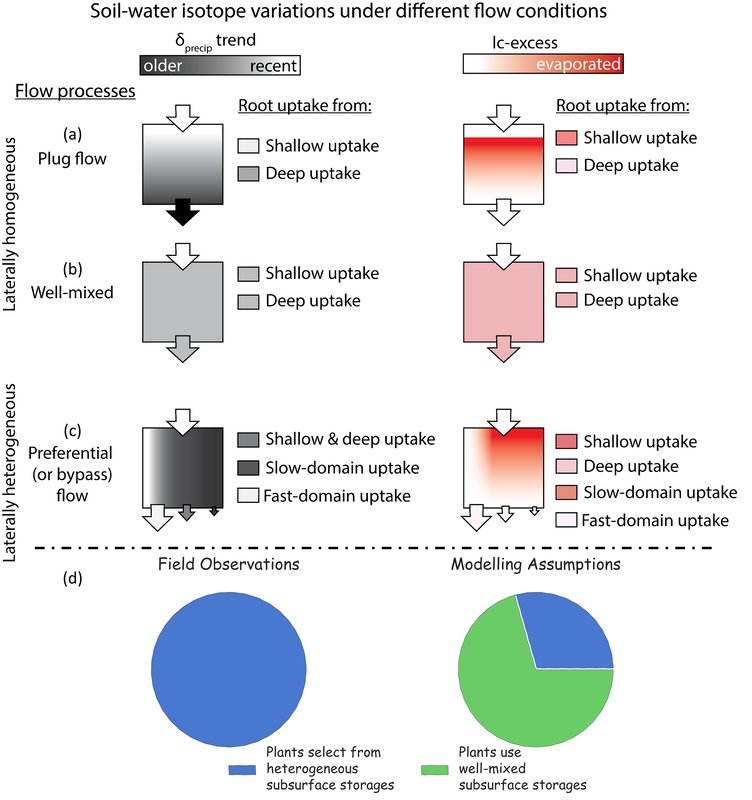
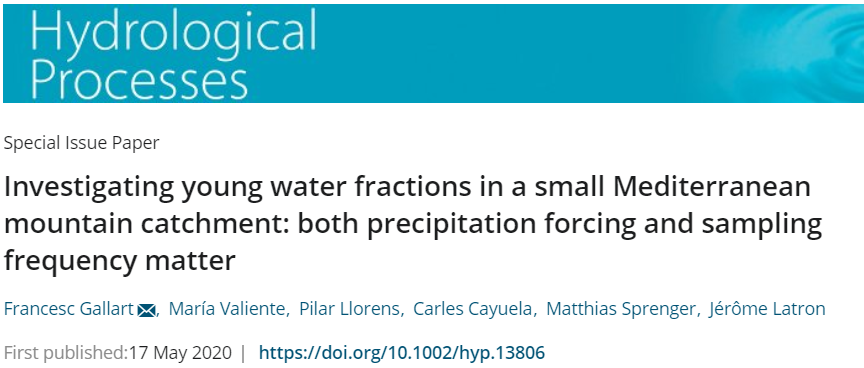
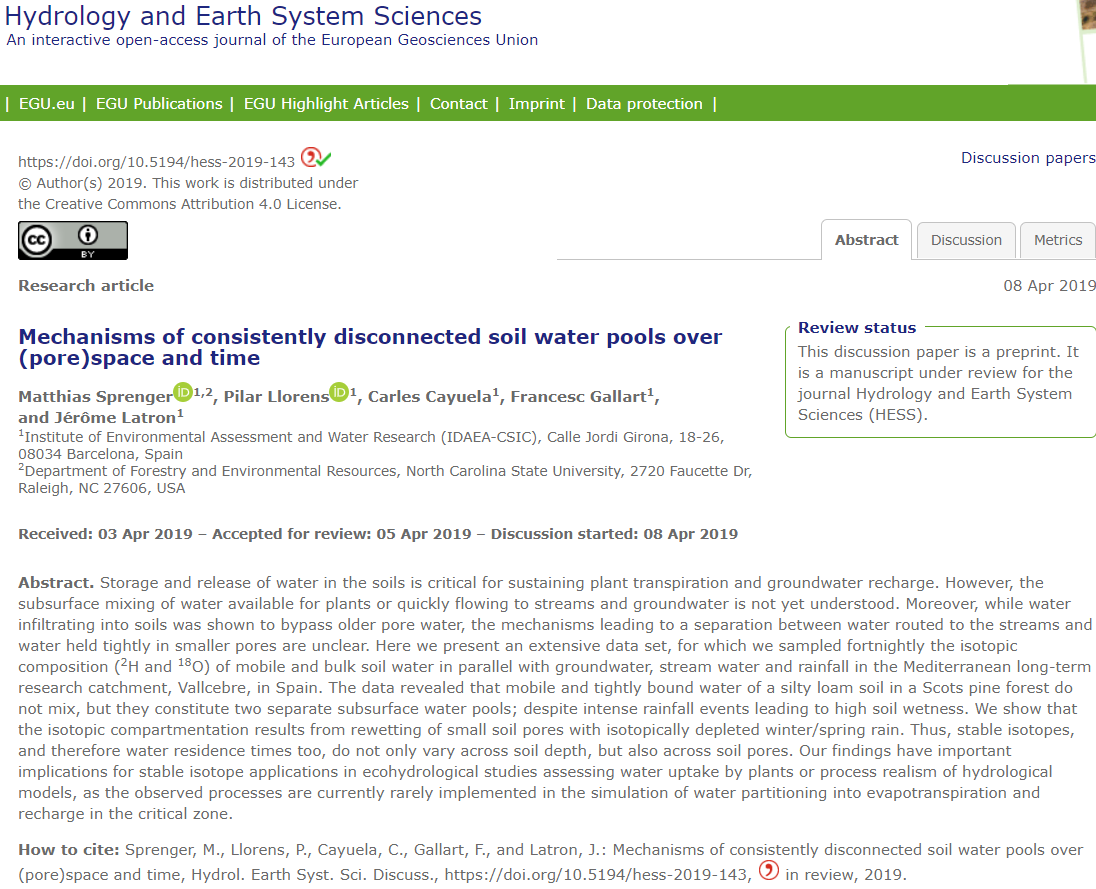
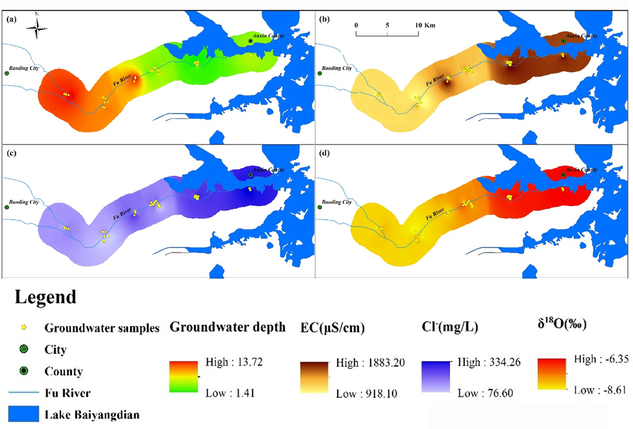
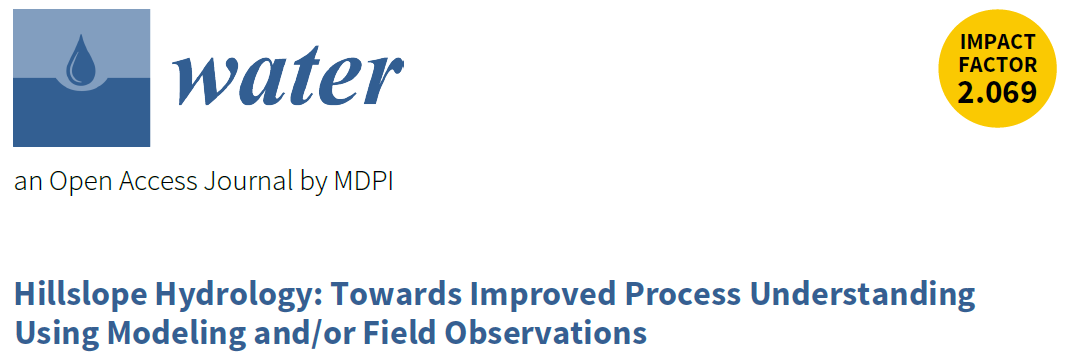
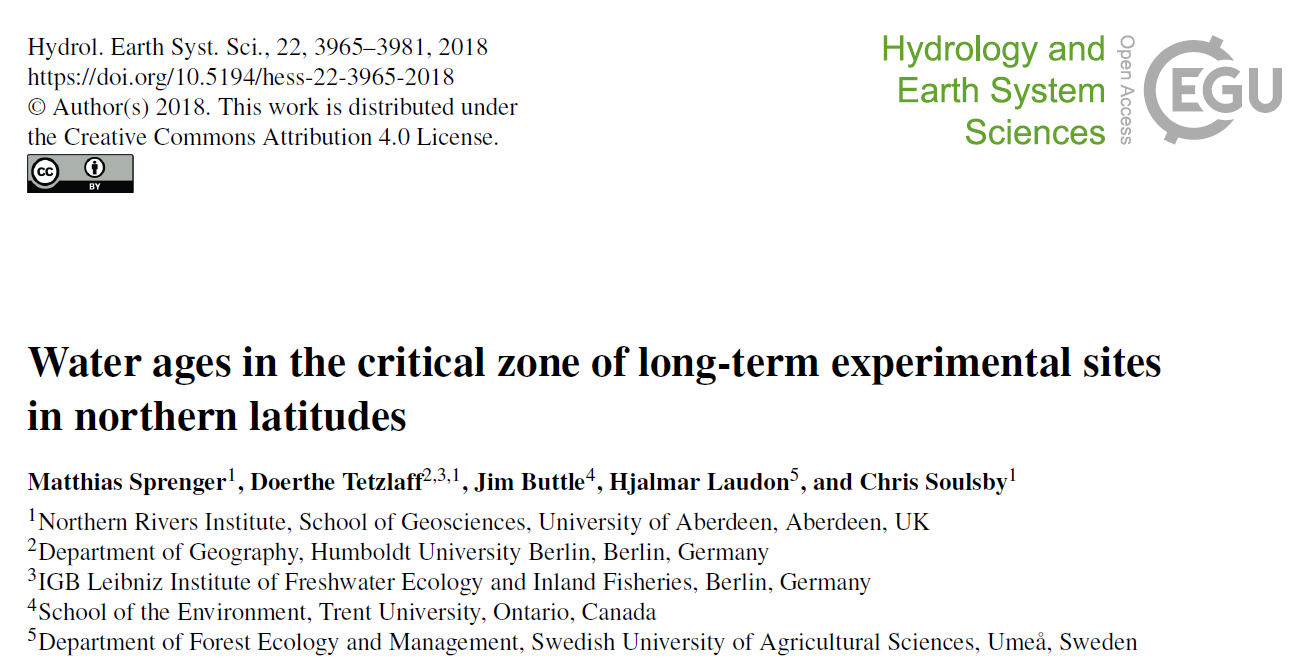

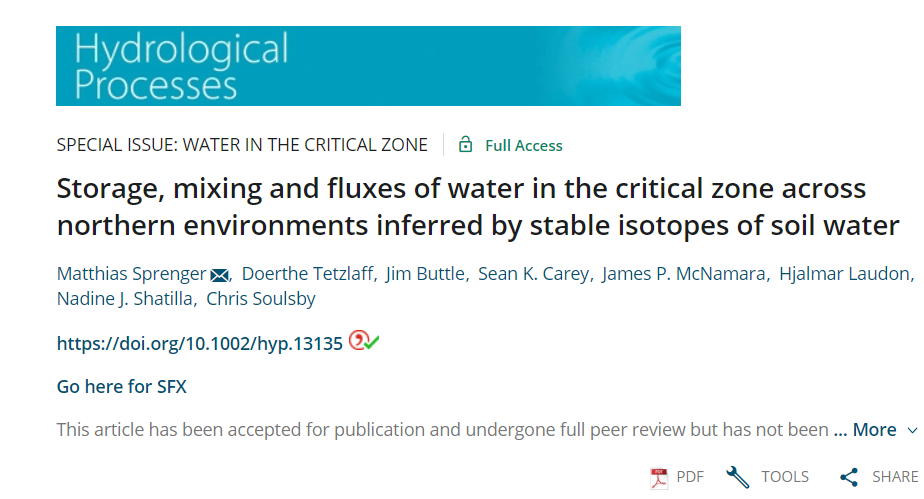
 RSS Feed
RSS Feed
